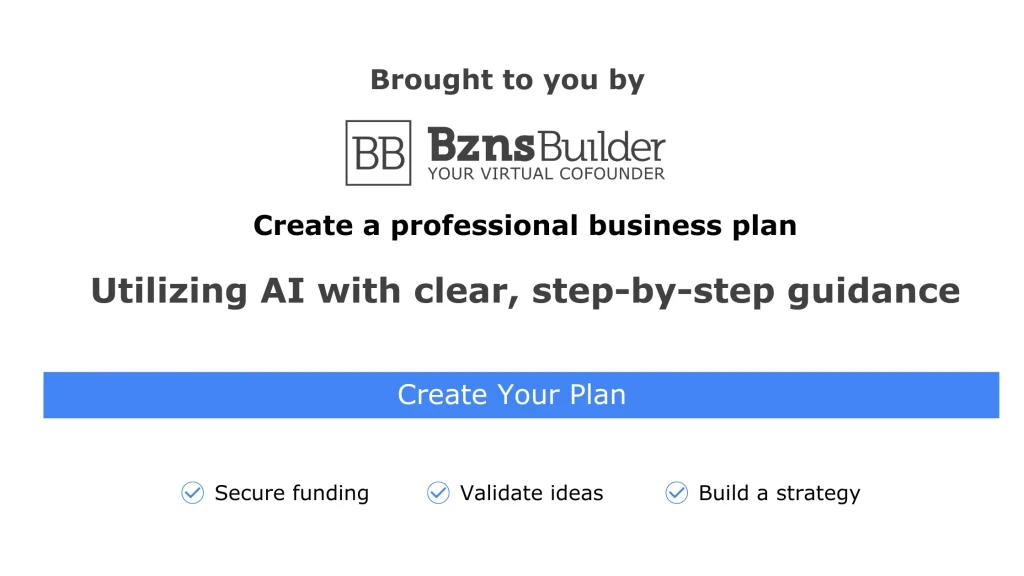How to Write a Business Plan: A Guide for Small Businesses

Writing a business plan doesn’t have to be overwhelming.
This step-by-step guide will show you how to write a business plan that’s clear, comprehensive, and tailored to impress investors and financial institutions. It will also equip you with the tools you need to launch, manage, and grow your business successfully.
The Basics of Writing a Business Plan
If you’re reading this guide, you likely already know why a business plan is essential. Writing a business plan helps you:
-
Secure funding from investors or financial institutions.
-
Strategically plan for growth and success.
-
Stay focused and keep your business on the right track.
Before diving into the details, let’s take a moment to define what a business plan is. At its core, a business plan provides an overview of your products or services and identifies your target customers. It outlines your strategy for building and growing your business, details your marketing approach, and analyzes your competition.
Most business plans also include financial forecasts. These forecasts help you set sales goals, budget for expenses, and project profits and cash flow. A solid business plan is much more than just a one-time document; it’s a dynamic guide that supports your decision-making and keeps you aligned with your objectives.
Once you’ve written your business plan, it becomes a valuable management tool. You can track progress toward your goals and make adjustments to your forecasts and budgets as your business evolves. Regular updates to your plan are crucial for maintaining a smarter, healthier business.
In this guide, we’ll also cover how to use your business plan effectively. While there are various types of business plans, this article focuses on creating an investor-ready plan, which includes all the key components needed to attract funding. If you’re just starting out, consider beginning with a one-page business plan. It’s quicker to draft and perfect for refining your ideas or creating a simple strategic outline for internal use.
Dig deeper: How to write a one-page business plan
What to Include in Your Business Plan
Executive Summary
The executive summary is an overview of your business and your plans. It comes first in your plan and is ideally just one to two pages. Most people write it last because it’s a summary of the complete business plan.
Ideally, the executive summary can act as a stand-alone document that covers the highlights of your detailed plan.
In fact, it’s common for investors to ask only for the executive summary when evaluating your business. If they like what they see in the executive summary, they’ll often follow up with a request for a complete plan, a pitch presentation, or more in-depth financial forecasts.
Your executive summary should include:
-
A summary of the problem you are solving
-
A description of your product or service
-
An overview of your target market
-
A brief description of your team
-
A summary of your financials
-
Your funding requirements (if you are raising money)
Dig deeper: How to write an effective executive summary
Products and Services Description
When writing a business plan, the products and services section is where you describe exactly what you’re selling and how it solves a problem for your target market. The best way to organize this part of your plan is to start by describing the problem that exists for your customers. After that, you can describe how you plan to solve that problem with your product or service.
This is usually called a problem and solution statement.
To truly showcase the value of your products and services, you need to craft a compelling narrative around your offerings. How will your product or service transform your customers’ lives or jobs? A strong narrative will draw in your readers.
This is also the part of the business plan to discuss any competitive advantages you may have, like specific intellectual property or patents that protect your product. If you have any initial sales, contracts, or other evidence that your product or service is likely to sell, include that information as well. It will show that your idea has traction, which can help convince readers that your plan has a high chance of success.
Market Analysis
Your target market is a description of the type of people you plan to sell to. You might even have multiple target markets, depending on your business.
A market analysis is the part of your plan where you bring together all the information you know about your target market. Essentially, it’s a thorough description of who your customers are and why they need what you’re selling. You’ll also include information about the growth of your market and your industry.
Be as specific as possible when describing your market. Include details such as age, income level, and location—these are known as “demographics.” If you can, also describe your market’s interests and habits as they relate to your business—these are “psychographics.”
Related: Target market examples
Include any relevant insights about your customers that explain why your product or service is right for them. With a well-defined target market, creating a sales and marketing plan becomes easier. You’ll know who your customers are, what they like to do, and the best ways to reach them.
Next, provide any additional details about your market:
-
What is the size of your market?
-
Is the market growing or shrinking?
Ideally, demonstrate that your market is growing and explain how your business is positioned to capitalize on industry changes.
Dig deeper: Learn how to write a market analysis
Competitive Analysis
Part of defining your business opportunity is determining what your competitive advantage is. To do this effectively, you need to know as much about your competitors as you do about your target customers.
Every business has competition. If you think you don’t, explore the alternatives available to your target market. For example, in the early days of cars, the main competition was horses. Similarly, early social media competed with traditional activities like reading books or watching TV.
A solid competitive analysis outlines the competitive landscape and explains how your business stands out. Maybe your products are better made, more affordable, or supported by superior customer service. Perhaps your location gives you an edge. Highlighting these advantages shows why your business is uniquely positioned for success.
Dig deeper: How to write a competitive analysis for your business plan
Marketing and Sales Plan
The marketing and sales plan outlines how you will position your product or service in the market, the channels and messaging you will use, and your sales tactics.
Start with a positioning statement. This explains how your business fits into the market and conveys the advantages of your product or service to your customers. Use insights from your competitive analysis to shape your positioning.
For example, you might position your company as the premium, highest-quality option in the market or emphasize being locally owned to appeal to customers who value supporting the local economy.
Once you define your positioning, integrate it with insights about your target market to craft your marketing strategy. This plan should detail how you’ll communicate your message to potential customers. Depending on your audience, strategies may range from social media advertising to podcast creation. Your marketing plan ensures customers discover your business and understand its value.
Your sales plan complements your marketing strategy by detailing how you’ll close deals once customers are interested. For instance, if your business involves a long sales process, describe how salespeople will guide potential customers through it. Alternatively, if customers can quickly make purchases online, outline that process.
Together, the marketing and sales plans provide a roadmap for attracting and converting customers into loyal buyers.
Dig deeper: What to include in your sales and marketing plan
Business Operations
When writing a business plan, the operations section describes the necessary requirements for your business to run smoothly. It’s where you detail how your business works and what day-to-day operations look like.
Depending on your business structure, your operations plan may include elements like:
-
Inventory
-
Supply chain management
-
Manufacturing processes
-
Equipment and technology
-
Distribution
If your business relies on large retailers like Amazon, Walmart, or grocery store chains to distribute products, outline the logistics and costs of getting products onto store shelves and discuss potential hurdles. For simpler business models, this section can be shorter and less detailed.
For service-based businesses, such as physical therapy or online software, use this section to describe the technology you’ll leverage, the components of your service, and the partnerships needed to deliver value to your customers.
Dig deeper: Learn how to write the operations chapter of your plan
Key Milestones and Metrics
While not mandatory, mapping out key business milestones and metrics can be incredibly useful for measuring your success.
Effective milestones clearly define tasks, set expectations, and include:
-
A description of each task
-
Proposed due dates
-
Responsible team members
If you have a budget, include projected costs for each milestone. Possible milestones might include:
-
Website launch date
-
Store or office opening date
-
First significant sales
-
Break-even date
-
Securing business licenses and approvals
Additionally, identify key metrics to track your success, such as:
-
Conversion rates
-
Customer acquisition costs
-
Profit per customer
-
Repeat purchases
Start with a few key metrics and expand as needed. Tailor metrics to your business model for the most actionable insights.
Dig deeper: How to use milestones in your business plan
Organization and Management Team
Investors look for great ideas backed by strong teams. Use this section to describe your current team, hiring plans, and the business’s organizational structure.
Highlight relevant experience for each team member to explain why they’re the right fit to bring your business vision to life. Address gaps by noting positions you still need to fill.
Include an overview of your company’s structure, such as:
-
LLC
-
C-corp
-
S-corp
-
Sole proprietorship
-
Partnership
Explain ownership division among partners if applicable. Investors and lenders will want to understand your company’s structure before considering funding.
Dig deeper: How to write about your company structure and team
How to Use AI to Help Write Your Business Plan
Generative AI tools such as ChatGPT can speed up the business plan writing process and help you think through concepts like market segmentation and competition. These tools are especially useful for taking ideas that you provide and converting them into polished text for your business plan.
The best way to use AI to write a business plan is to leverage it as a collaborator, not a replacement for human creative thinking and ingenuity.
AI can come up with lots of ideas and act as a brainstorming partner. It’s up to you to filter through those ideas and figure out which ones are realistic enough to resonate with your customers.
There are pros and cons of using AI to help with your business plan. So, spend some time understanding how it can be most helpful before just outsourcing the job to AI.
Learn more: 10 AI prompts you need to write a business plan
Writing Tips and Strategies
To help streamline the business plan writing process, here are a few tips and key questions to answer to make sure you get the most out of your plan and avoid common mistakes.
Determine why you are writing a business plan
Knowing why you are writing a business plan will determine your approach to your planning project. For example, if you are writing a business plan for yourself or just to use inside your own business, you can probably skip the section about your team and organizational structure. If you’re raising money, you’ll want to spend more time explaining why you’re looking to raise the funds and exactly how you will use them.
Regardless of how you intend to use your business plan, think about why you are writing and what you’re trying to get out of the process before you begin.
Keep things concise
Probably the most important tip is to keep your business plan short and simple. There are no prizes for long business plans. The longer your plan is, the less likely people are to read it. Focus on trimming things down to the essentials your readers need to know. Skip the extended, wordy descriptions and instead focus on creating a plan that is easy to read—using bullets and short sentences whenever possible.
Have someone review your business plan
Writing a business plan in a vacuum is never a good idea. Sometimes it’s helpful to zoom out and check if your plan makes sense to someone else. You also want to make sure that it’s easy to read and understand. Don’t wait until your plan is “done” to get a second look. Start sharing your plan early, and find out from readers what questions your plan leaves unanswered. This early review cycle will help you spot shortcomings in your plan and address them quickly, rather than finding out about them right before you present your plan to a lender or investor.
If you need a more detailed review, you may want to explore hiring a professional plan writer to thoroughly examine it.
Use a free business plan template and examples to get started
Knowing what information to include in a business plan is sometimes not quite enough. If you’re struggling to get started or need additional guidance, it may be worth using a business plan template. There are plenty of great options available. If you’re looking for a free downloadable business plan template, you can get one right now; download the template used by more than 1 million businesses. Or, if you just want to see what a completed business plan looks like, check out a library of over 550 free business plan examples. There’s also a growing list of industry-specific business planning guides with tips tailored to your business type.
Common pitfalls and how to avoid them
It’s easy to make mistakes when you’re writing your business plan. Some entrepreneurs get sucked into the writing and research process and don’t focus enough on actually getting their business started. Here are a few common mistakes and how to avoid them:
- Not talking to your customers: It’s easy to assume that your product or service is something that people want. Before you invest too much in your business and the planning process, make sure you talk to your prospective customers and understand their needs.
- Overly optimistic sales and profit forecasts: Entrepreneurs tend to be optimistic about the future. Temper that optimism and make sure your forecasts are grounded in reality.
- Spending too much time planning: Planning is crucial, but you also need to get out, talk to customers, build prototypes, and figure out if there’s a market for your idea. Balance planning with action.
- Not revising the plan: As you learn more about what works and what doesn’t, revise your plan, budgets, and forecasts. This will give you a realistic picture of where your business is heading.
- Not using the plan to manage your business: A good business plan is a management tool. Use it to track progress and reach your goals—don’t let it gather dust on a shelf.
Presenting Your Business Plan
The planning process forces you to think through every aspect of your business and answer questions that you may not have thought of. That’s the real benefit of writing a business plan – the knowledge you gain about your business that you may not have been able to discover otherwise.
With all of this knowledge, you’re well prepared to convert your business plan into a pitch presentation to present your ideas.
A pitch presentation is a summary of your plan, just hitting the highlights and key points. It’s the best way to present your business plan to investors and team members.
Dig deeper: Learn what key slides should be included in your pitch deck
Use Your Business Plan to Manage Your Business
One of the biggest benefits of planning is that it gives you a tool to manage your business better. With a revenue forecast, expense budget, and projected cash flow, you know your targets and where you are headed.
And yet, nothing ever goes exactly as planned – it’s the nature of business.
That’s where using your plan as a management tool comes in. The key to leveraging it for your business is to review it periodically and compare your forecasts and projections to your actual results.
Start by setting up a regular time to review the plan – a monthly review is a good starting point. During this review, answer questions like:
-
Did you meet your sales goals?
-
Is spending following your budget?
-
Has anything gone differently than what you expected?
Now that you see whether you’re meeting your goals or are off track, you can make adjustments and set new targets.
-
Maybe you’re exceeding your sales goals and should set new, more aggressive goals. In that case, maybe you should also explore more spending or hiring more employees.
-
Or maybe expenses are rising faster than you projected. If that’s the case, you would need to look at where you can cut costs.
A plan, and a method for comparing your plan to your actual results, is the tool you need to steer your business toward success.
Learn More: How to run a regular plan review








